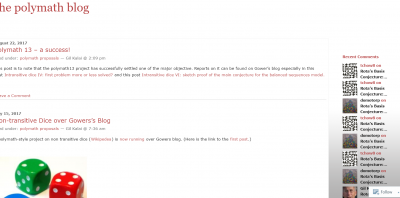Who?
The dissemination of the project was initiated by the founders of the project: Timothy Gowers and Michael Nielsen through Gowers’s blog entitled “Is massively collaborative mathematics possible?” released in January 2009. Additionally, Terence Tao started to work very actively in the dissemination, shortly after Gowers's blog was released. Their aim was to target mathematicians that are motivated to bring new ideas and exchange them with others in order to solve difficult math problems, but also academics, teachers, students and other individuals interested in maths.
What & How?
Dissemination is conducted in terms of text and video through public information blogs (Gowers 2009 & Terence Tao's Blog), the home page, wiki pages (Polymath Wiki page) , the Q&A site MathOverflow (MathOverflow) and YouTube videos (Terence Tao’s videos) . There are papers available that describe the outcomes of the Polymath projects, which are uploaded to arXiv and are also submitted to the Journal of Mathematics of Computation or Nature (DHJ Polymath 2014, Tao et. al. 2012, and Gowers and Nielsen 2009).
When?
The focus of the PolyMath project was to start with the dissemination in the very early stages of the project. So, the most important dissemination activities took place after the first research lifecycle phase - Design. From the first dissemination activities, new opportunities and projects were created. In general, dissemination is noticeable after each research lifecycle phase.
Relation to Open Science
Based on the policy of the Polymath project, all collaboration records, outcomes and results are generally accessible to the public audience, so that they can be reused by mathematicians. The results of a Polymath project, for example, helped to solve problems defined in another Polymath project.
Nevertheless, the outcomes are not explicitly put under a permissive license. For articles published in arXiv, for example, rights are only granted to arXiv.org (i.e., a perpetual, non-exclusive license to distribute the articles), and for Nature journal articles, rights are managed by the Nature Publishing Group.
Particular problems and proposed solutions are reviewed and discussed by the members of each Polymath project in corresponding pages and blogs. There is, however, no evidence that the number of upvotes of the proposed math problems in MathOverflow is one of the criteria that proposals turn to Polymath projects - at least this is not explicitly stated. When defining the criteria, the Polymath community has rather been focusing on projects in the fields of algebraic geometry, algebraic topology, group theory, logic, and set theory.
Effort
YouTube videos of Terence Tao can be characterized as high-quality videos. Public blogs are managed and moderated by individuals. Similarly, wiki and Q&A sites are managed by members of individual projects. Hence, dissemination costs can be estimated as medium (< EUR 50,000).
Impact
The project has been very well received by the target audience; the first problem introduced in the first Polymath project has been solved within one and a half months. Since then, the Polymath project solved very difficult mathematical problems or made progress in solving them.
Polymath papers are usually signed with a group pseudonym that consists of the initials of Polymath project title. A link to the full working record is also provided. So, for authors, it is a bit difficult to list such publications in their CVs, for example, or increase their visibility. Authors/participants got more informal recognition, because people were following their work, their blogs, but there is a lack of a formal recognition (Terence Tao’s videos). However, there are peer reviewed papers that investigate in detail the concept, scope and impact of Polymath projects.
Gender
Co-founders of the project (Timothy Gowers and Michael Nielsen) and persons playing a major role in the dissemination (i.e., Terence Tao) are men. As a characteristic for the discipline of the project (mathematics), most of the collaborators in the Polymath projects are men. The proposed math problems that became Polymath projects were also contributed by men. There is no evidence of any dissemination activity targeted at women. The language used in the dissemination materials and communication channels seems not to be gender sensitive.
Highlight
|
||
|---|---|---|
|
With his blog “Is massively collaborative mathematics possible?” (released January 2009), Timothy Gowers managed to gain the attention of many mathematicians that started to discuss very difficult problems in mathematics by commenting on his blog. Collaboration continued by defining unsolved problems and solving them or making progress on solving them. As a very important fact, results of a particular Polymath project were used as inputs that helped to solve problems in other Polymath projects. |
||
Link
For a more extensive analysis of the Polymath project case study, please follow the link: http://openup-h2020.eu/wp-content/uploads/2017/01/OpenUP_D4.1_Practices-evaluation-and-mapping.-Methods-tools-and-user-needs.pdf





